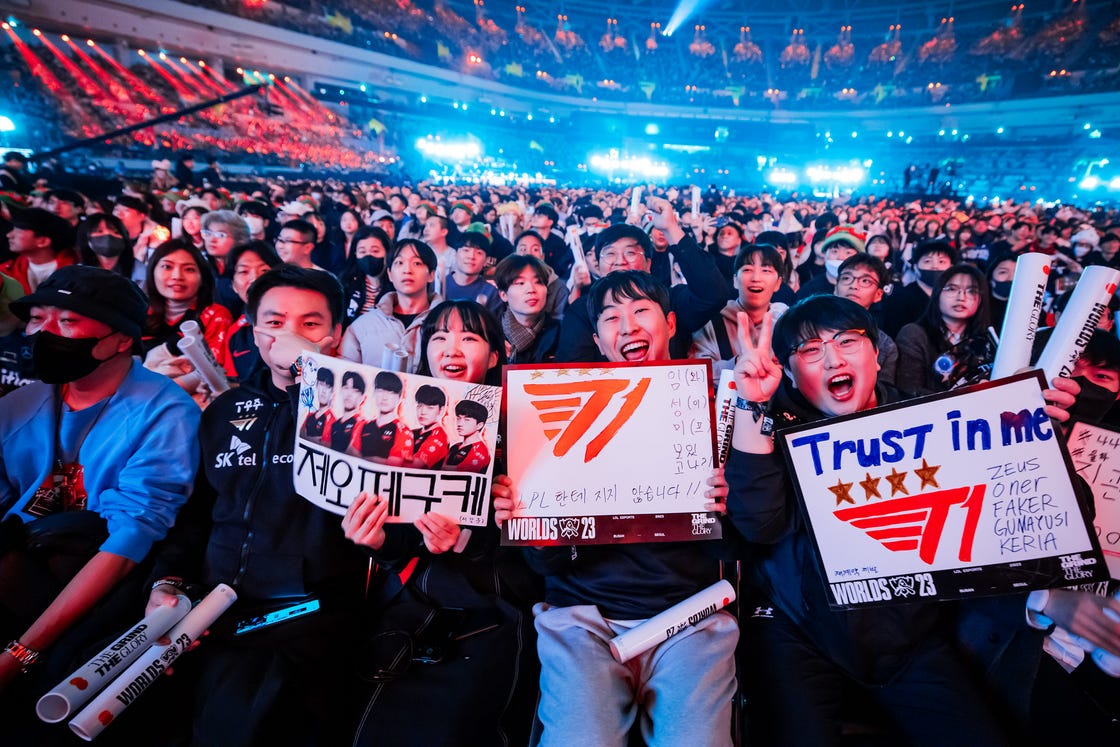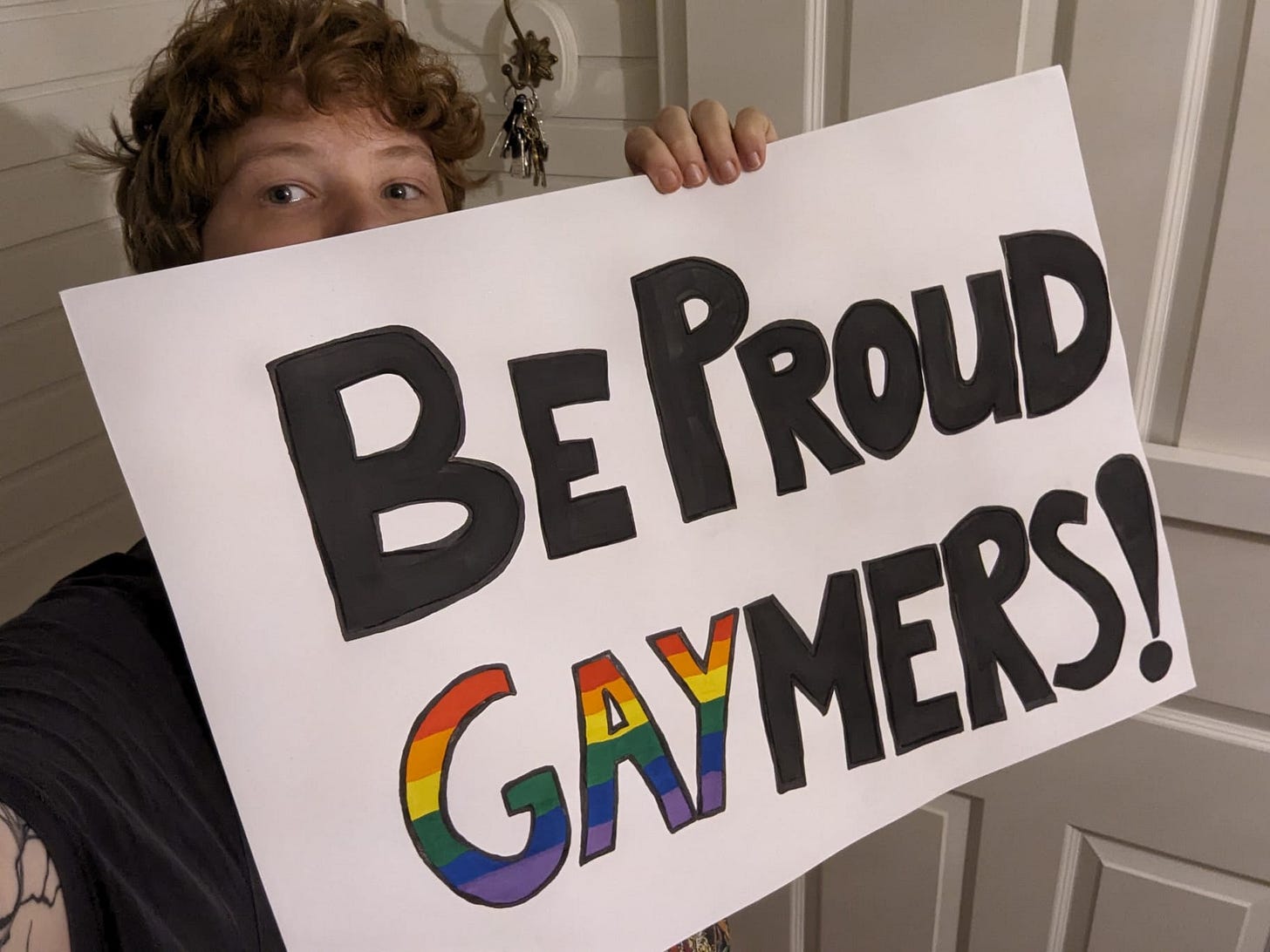The Public Perils of Tangling With Fandom
A minor incident at the Riot Games Arena in Berlin this week highlights the dangers of messing with fans bearing signs, but Riot’s policies are in line with other sports leagues.

On Friday, X/Twitter user Cori0lis tweeted that his friends’ sign was confiscated by LEC (short for League of Legends EMEA Championship) staff at the Riot Games Arena in Berlin, Germany, during a live event.
“My friend is at @LEC studio with this sign. When they saw the sign on broadcast, the whole security team came over and told them "that's not wanted here". What a nice way to make queer people feel safe and wanted in this community.”
The sign in question reads:

Cori0lis later notes that the sign was returned, with apologies: “He got the sign back and an apology thanks everyone for your reactions and especially @sjokz and @LaureBuliiV.”
This incident was (we guess) simply the result overzealous staff trying to enforce basic rules related to political speech during broadcast—we’ll leave the arguments for whether or not using the word “gaymer” (which is a widely accepted terms these days to describe gays and lesbians who enjoy playing games) is political speech or not.
Riot does have policies on signage—which we’ll get to later, but staff was likely just trying to enforce the rules, despite someone allegedly saying, “that’s not wanted here.”
On Saturday I tweeted that “The LEC and other leagues are playing with fire here with this kind of behavior.” So what does that mean? When I say “playing with fire,” I mean in the court of public opinion. Going from “we support diversity and inclusion” to banning signs that express that is a crisis management expert’s sicko fantasy. It’s not a good look, it will receive a TON of public backlash, and ultimately erode goodwill to fans who are LGBTQ+.
But here’s the thing that fans should know: professional sports has much stricter policies on signs, banners, and flags, and Riot—in building League of Legends Esports as fan-focused entertainment with all of its trappings—is generally in line with just about everyone else. It should also be noted that many of the decisions on what’s allowed or not allowed at any given time during a live event is dependent on who owns the venue, the local staff, and local public sentiment on issues. Here’s a quick run-down of policies from some of the biggest sports leagues in the world.
Fan Rules at Professional Sporting Events
The National Basketball Association (NBA) has strict rules on banners, signage, and flags. This particular prohibition is relevant, in our view:
“Clothing, garments or signs displaying explicit language, profanity or derogatory characterization towards any person(s).”
U.S. Soccer’s Fan Code of Conduct notes two points that are relevant for the purposes of this conversion under “prohibited” behavior:
“Racial, sexual, xenophobic, sexist, obscene, abusive, and/or homophobic language (including on signs or visible representations), chants, or gestures or conduct.”
Under prohibited items at events:
Commercial or political messaging, including signage and apparel.
Banners or any other item that could obstruct the view of other fans.
The National Football League established a Fan Code of Conduct in 2008, which all franchised teams signed on to. While teams might have their own specific rules on behavior, they generally follow NFL guidance. Here’s a vague excerpt from the Green Bay Packers’ Fan Code of Conduct page that could be considered relevant.
“Any other conduct deemed to be beyond the bounds of reason.”
Generally, facilities staff have discretion to remove patrons or request signs or other visual displays during games that they consider “inappropriate” or against the code of conduct that fans agree to when they buy a ticket for an event.
Under the “Can I bring a flag or a banner?” section, FIFA offers the following guidance:
Yes. Small flags, banners and posters are permitted provided they do not exceed 2m x 1.5m. Flags, banners or posters exceeding these dimensions, it must be approved in advance by the event organisers. Requests to bring fan material into the stadium can be made here from 15 February and must be placed at least 48 hours before the kick-off of the match.
Approvals for oversized fan material will not be granted on-site if no evidence of prior approval from the event organisers is provided. Flags, banners or posters must be made of a non-flammable material. Items of a political, offensive, sexual, discriminatory or commercial nature are strictly prohibited and may result in expulsion from the stadium.
USA Cycling offers the following guidance on fan behavior in its Fan Code of Conduct rules:
Conduct that interferes with other fans’ enjoyment of the spectator experience.
Displaying signs, symbols, images, using language, or making gestures that are threatening, abusive, or discriminatory on the basis of race, ethnicity, national origin, religion, gender, gender identity, ability, or sexual orientation.
Wearing obscene or indecent clothing.
For NASCAR, fans don’t typically bring signs, but the general rule is that fan displays should not obscure the view for other patrons. Generally, venues such as Atlanta Motor Speedway have their own rules for fans. Here are a few examples of “prohibited items” that are semi-related to fan displays/signage:
displays of the Confederate Flag or any other offensive displays.
items restricted by local, state, and federal laws into the Speedway.
obscene or indecent clothing
Generally, World Wrestling Entertainment (WWE) has rules on signs with explicit or offensive language, signs that promote competing products and related wrestlers (AEW, TNA, NJPW, ROH), copyrighted material, and more. Some of this is also really dependent on local staff and venue policies.
Riot’s Sign Policy
Riot has long-standing rules on signage and displays from fans. For Worlds 2023 it had the following rules in place:
Sign Policy
Banners, Signs and Flags
Banners, signs and flags must be event related and contain no commercial messages, logos, political, regional, separatist or country flags or political endorsements. Banners, signs and flags should not contain offensive or obscene language. Banners, signs and flags which contain graphic depictions must be in good taste and contain no depictions that would offend or embarrass other patrons.
Patrons must adhere to the following guidelines:
Banners, signs and flags must be small enough for one person to hold and no larger than 60cm x 60cm.
Banners, signs and flags may not obstruct the view of others.
Banners, signs and flags should be constructed of either vinyl, cloth, paper or other lightweight materials.
Banners, signs and flags may not be attached to poles or sticks.
Patrons will not be permitted to display more than one banner, sign or flag.
Riot Games reserves the right to remove any and all banners, signs or flags not in compliance with the above policy or which, in their sole judgment, may be offensive to others or in instances where the banners, signs or flags continue to obstruct the view of others.
LED signs that comply with the above policy, will be permitted, however, they may not be larger than 60cm x 60cm.
Former U.S. House of Representatives Speaker of the House Tip O'Neill—who gained public prominence during the Ronald Reagan eight-year presidency in the 1980s—was fond of saying the phrase "all politics is local." What that means for politicians is that local matters—economic and social—are what drive constituents' hearts and votes, generally.
Another phrase that comes to mind is "when in Rome," which means that when visiting another land, one tries to recognize local customs and laws (so that you avoid putting yourself in both real or imagined peril). What's weird about this particular situation—which happened in Berlin—is that the city is ultra progressive when it comes to LGBTQ+ rights and supporting diversity. This story would make more sense if it happened in Riyadh or Qatar; we'd all nod our heads and move on. We might disapprove of it happening, but we also recognize that the local culture and government is either uncomfortable with or downright hostile towards the messaging.
But saying all that, Riot's policy on signage is generally in line with sports leagues, and much of what is accepted or not accepted is based on local sentiment, venue policies, and the decision-making of on-site staff. - James Fudge.


I think part of the difference with this is Riot is trying to have its cake and eat it too when it comes to being "the same as professional sports." They want to preach that they're NOT like professional sports when it suits them, but then lean on policies and other structures when it does.
If you spend your time building up the reputation for being inclusive and welcoming to all, supporting LGBTQ causes and elevating representation of minorities, you look hypocritical in situations like this, where anyone familiar with traditional sports goes "duh, no politics" and points at the policies that are already in place.
For many people who would be affected by this (either getting their signs taken away, or being hurt that signs were taken away) it doesn't matter that "other people already do it"; Riot has signaled previously that they were content to "take chances" — it's arguably in each case how much risk is involved — to be different.
I don't think Riot can get away with a "no politics with signs" rule because they've made it clear that they believe LGBTQ communities are marginalized. To their audience, taking away a LGBTQ sign contributes to that marginalization. In this situation, the sign is at least tangentially related to the broadcast ("Gaymers" as a general term) but if you don't have control or a limit, you open up risk for the signs to eventually impact the broadcast. Wrestling grapples (no pun intended) with this issue as well.
We saw how Overwatch League reacted to Pepe signage, and it's hard to have specific and enforceable rules beyond "we favor [group], they're cool." A lot of people don't like seeing this kind of enforcement strategy because depending on the scenario, they can justify why it's hypocritical.
The question becomes about which set of consequences are worse, and whose dollar they care about more: the people angry about LGBTQ signs, or the people who would get angry about a policy for a lack of LGBTQ signs. I'd imagine it's the latter.